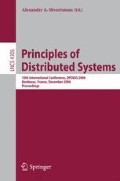Abstract
We propose the correctness proofs and the complexity analysis for the first self-stabilizing constructions of connected overlays for wireless networks (eg. MANETs, WSN) based on the computation of Connected Dominating Set (CDS). The basic idea is to construct an overlay that contains a small number of nodes, but still obtain full connectivity of the network while only relying on local exchanges of information and knowledge. We adopt two methodologies of construction: the first methodology consists of two parallel tasks, namely, computing a maximal independent set (MIS) and then adding bridge nodes between the MIS nodes. The second methodology computes a connected dominating set using the observation that a dominator is a bridge between nodes that do not share the same neighborhood.
The proposed algorithms are fully decentralized and are designed in a self-stabilizing manner in order to cope with transient faults, mobility and nodes join/leave. In particular, they do not need to be (re)initialized after a fault or a physical topology change. That is, whatever the initial configuration is, the algorithms satisfy their specification after a stabilization period. The convergence time of our algorithms is linear in the size of the network and they use only one extra bit of memory. We also present an optimization of our algorithms that reduces the number of nodes in the cover. However, the optimization increases the convergence time with a constant factor.
Access this chapter
Tax calculation will be finalised at checkout
Purchases are for personal use only
Preview
Unable to display preview. Download preview PDF.
References
Alzoubi, K., Peng-Jun, W., Frieder, O.: Weakly connected dominating sets and sparse spanners in wireless adhoc networks. In: ICDCS 2003 Proceedings of the 23rd International Conference on Distributed Computing Systems, pp. 96–104 (2003)
Ankur, J., Gupta, A.: A distributed self-stabilizing algorithm for finding a connected dominating set in a graph. In: PDCAT 2005 (2005)
Dai, F., Wu, J.: Distributed dominant pruning in ad hoc networks. In: Proceedings of ICC 2003 (2003)
Das, B., Bharghavan, V.: Routing in ad-hoc networks using minimum connected dominating sets. In: ICC (1), pp. 376–380 (1997)
Das, B., Sivakumar, R., Bharghavan, V.: Routing in ad hoc networks using a spine. In: ICCCN, pp. 34–41 (1997)
Datta, A.K., Gradinariu, M., Linga, P., Raipan-Parvéde, P.: Self-stabilizing query covers in sensor networks. In: SRDS (2005)
Datta, A.K., Gradinariu, M., Patel, R.: Optimal self* query region covers in sensor networks. In: ISPAN (2005)
Datta, A.K., Gradinariu, M., Patel, R.: Dominating-sets based self-stabilizing minimum query covers in sensor networks. Technical Report 1803, IRISA/Universite Rennes 1 (2006)
Dijkstra, E.W.: Self stabilizing systems in spite of distributed control. Communications of the Association of the Computing Machinery 17(11), 643–644 (1974)
Dolev, S.: Self-Stabilization. MIT Press, Cambridge (2000)
Drabkin, V., Friedman, R., Gradinariu, M.: Self-stabilizing wireless connected overlay. Technical report, LIP6, Universite Paris 6 (2006)
Friedman, R., Gradinariu, M., Simon, G.: Locating cache proxies in manets. In: MobiHoc 2004 Proceedings of the Thifth ACM International Symposium on Mobile Ad Hoc Networking and Computing (2004)
Gouda, M.G., Herman, T.: Adaptive programming. IEEE Trans. Software Eng. 17(9), 911–921 (1991)
Gradinariu, M., Tixeuil, S.: Self-stabilizing vertex coloring of arbitrary graphs. In: Proceedings of OPODIS 2000, STUDIA INFORMATICA, pp. 55–70 (2000)
Herman, T., Tixeuil, S.: A distributed TDMA slot assignment algorithm for wireless sensor networks. In: Nikoletseas, S.E., Rolim, J.D.P. (eds.) ALGOSENSORS 2004. LNCS, vol. 3121, pp. 45–58. Springer, Heidelberg (2004)
Ingelrest, F., Simplot-Ryl, D., Stojmenovic, I.: Smaller connected dominating sets in ad hoc and sensor networks based on coverage by two-hop neighbors. Technical report, Institut National De Recherche En Informatique Et En Automatique (April 2005)
Kakugawa, H., Masuzawa, T.: A self-stabilizing minimal dominating set algorithm with safe convergence. In: IEEE Parallel and Distributed Processing Synmposium (IPDPS 2006) (2006)
Liu, H., Pan, Y., Cao, J.: An improved distributed algorithm for connected dominating sets in wireless ad hoc networks. In: Cao, J., Yang, L.T., Guo, M., Lau, F. (eds.) ISPA 2004. LNCS, vol. 3358, pp. 340–351. Springer, Heidelberg (2004)
Peng-Jun, W., Alzoubi, K., Frieder, O.: Distributed construction of connected dominating sets in wireless adhoc networks. In: INFOCOM 2002 Proceedings of the Conference on Computer Communications (2002)
Theoleyre, F., Valois, F.: About the self-stabilization of a virtual topology for self-organization in ad hoc networks. In: Self-Stabilizing Systems, pp. 214–228 (2005)
Wu, J.: Extended dominating-set-based routing in ad hoc wireless networks with unidirectional links. IEEE Transactions on Parallel and Distributed Systems 13(9), 866–881 (2002)
Wu, J., Gao, M., Stojmenovic: On calculating power-aware connected dominating sets for efficient routing in ad hoc wireless networks. In: Proc. of the 30th International Conference on Parallel Processing (ICPP 2001), pp. 346–353 (2001)
Wu, J., Li, H.: On calculating connected dominating set for efficient routing in ad hoc wireless networks. In: Proc. of the 3th Int. Workshop on Discrete Algothrithms and Methods for MOBILE Computing and Communications (DialM 1999), pp. 7–14 (1999)
Xu, Z., Hedetniemi, S.T., Goddard, W., Srimani, P.K.: A synchronous self-stabilizing minimal domination protocol in an arbitrary network graph. In: IWDC 2003 (2003)
Das, S., Zhou, Z., Gupta, H.: Fault tolerant connected sensor cover with variable sensing and transmission. SECON (2005)
Author information
Authors and Affiliations
Editor information
Editors and Affiliations
Rights and permissions
Copyright information
© 2006 Springer-Verlag Berlin Heidelberg
About this paper
Cite this paper
Drabkin, V., Friedman, R., Gradinariu, M. (2006). Self-stabilizing Wireless Connected Overlays. In: Shvartsman, M.M.A.A. (eds) Principles of Distributed Systems. OPODIS 2006. Lecture Notes in Computer Science, vol 4305. Springer, Berlin, Heidelberg. https://doi.org/10.1007/11945529_30
Download citation
DOI: https://doi.org/10.1007/11945529_30
Publisher Name: Springer, Berlin, Heidelberg
Print ISBN: 978-3-540-49990-9
Online ISBN: 978-3-540-49991-6
eBook Packages: Computer ScienceComputer Science (R0)

